Body length: 6–18 mm.
Eyes: eye interommatidial setaeseta:
a sclerotized hair-like projection of the cuticle
absent, eye entire/shallowly emarginateemarginate:
notched at the margin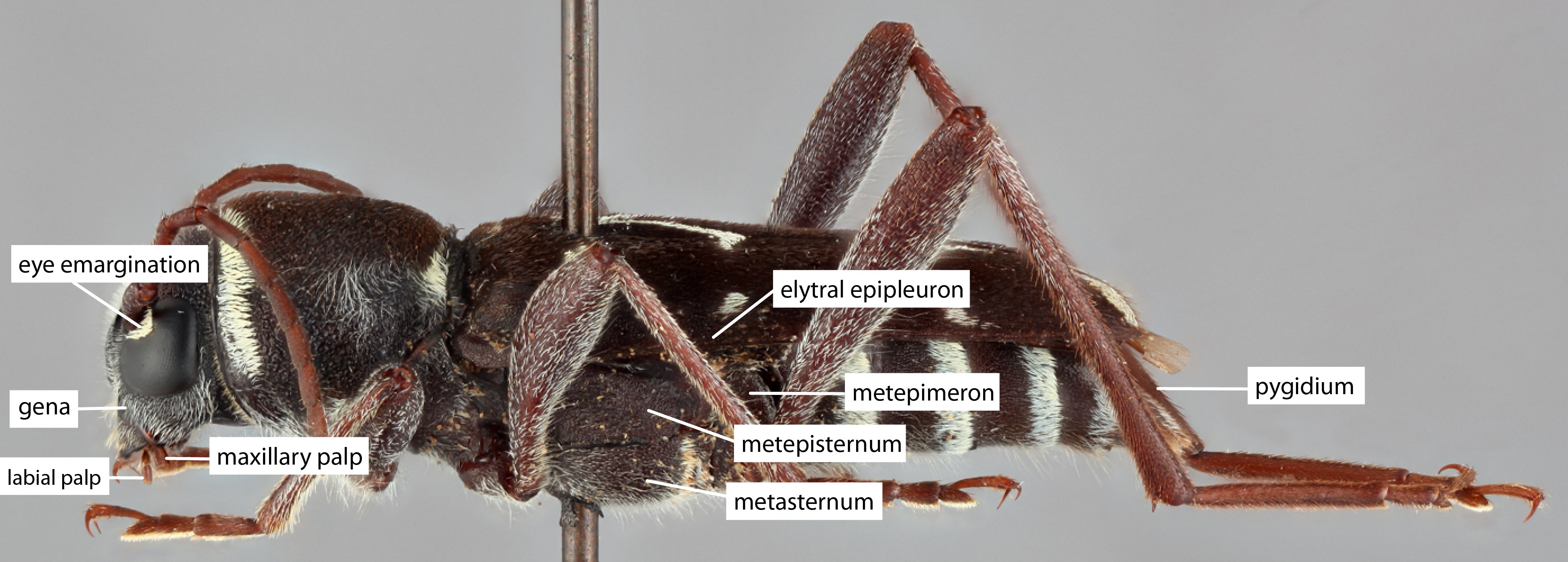 , eye ommatidial density fine.
, eye ommatidial density fine.
Antennaeantenna:
in larval and adult insects, paired segmented appendages, borne one on each side of the head, functioning as sense organs and bearing a large number of sensilla
: antennal length reaches between basebase:
the part of any appendage or structure that is nearest the body
and end of elytraelytron:
the leathery forewing of beetles, serving as a covering for the hind wings, commonly meeting opposite elytron in a straight line down the middle of the dorsum in repose
, antennal flagellar segments elongateelongate:
much longer than wide
, scapescape:
the first proximal segment of the antenna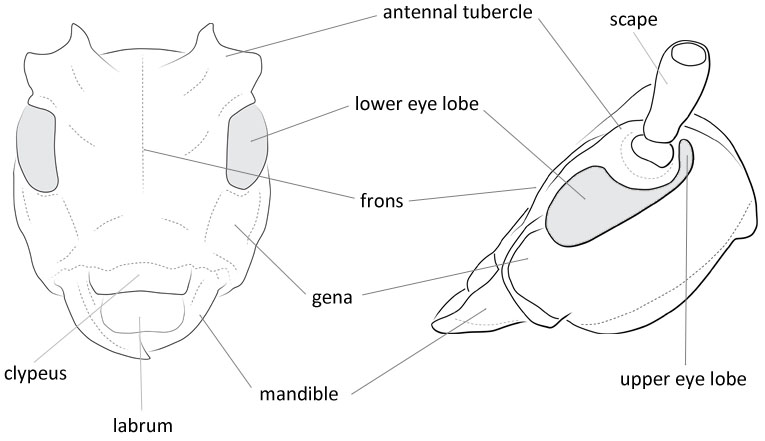 smooth/punctate at apexapex:
smooth/punctate at apexapex:
end of any structure distad to the base
, antennal scapescape:
the first proximal segment of the antenna ≥ segment 3, rarely segment 3 > scapescape:
≥ segment 3, rarely segment 3 > scapescape:
the first proximal segment of the antenna .
.
Pronotumpronotum:
the upper and dorsal part of the prothorax
: pronotumpronotum:
the upper and dorsal part of the prothorax
shape subquadratesubquadrate:
not quite a square
, pronotumpronotum:
the upper and dorsal part of the prothorax
lateral armature absent.
Prosternum: prosternal processprosternal process:
a posterior extension of the prosternum between the coxae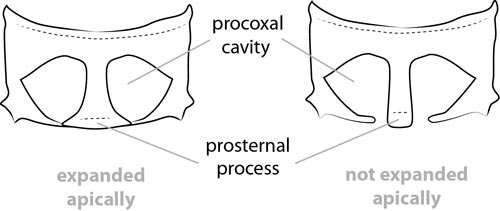 dilated at apexapex:
dilated at apexapex:
end of any structure distad to the base
or not dilated at apexapex:
end of any structure distad to the base
, procoxal cavities open posteriorly, rarely closed posteriorly.
Elytraelytron:
the leathery forewing of beetles, serving as a covering for the hind wings, commonly meeting opposite elytron in a straight line down the middle of the dorsum in repose
: elytral length reaching or close to end of abdomen, elytral apicesapex:
end of any structure distad to the base
rounded or truncatetruncate:
cut off squarely at the tip
, emarginateemarginate:
notched at the margin or with tooth or spinespine:
or with tooth or spinespine:
a protuberance with an acute (sharp) distal end
, elytral color black or yellow, elytral color pattern present or absent.
Legs: visible tarsomerestarsomere:
subdivision or article of the tarsus, usually numbering from two to five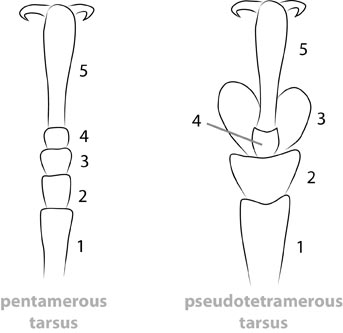 : 4, femora slender, protibial spursprotibial spur:
: 4, femora slender, protibial spursprotibial spur:
sclerotized spine(s) located at the distal tibia; can be single, double, or absent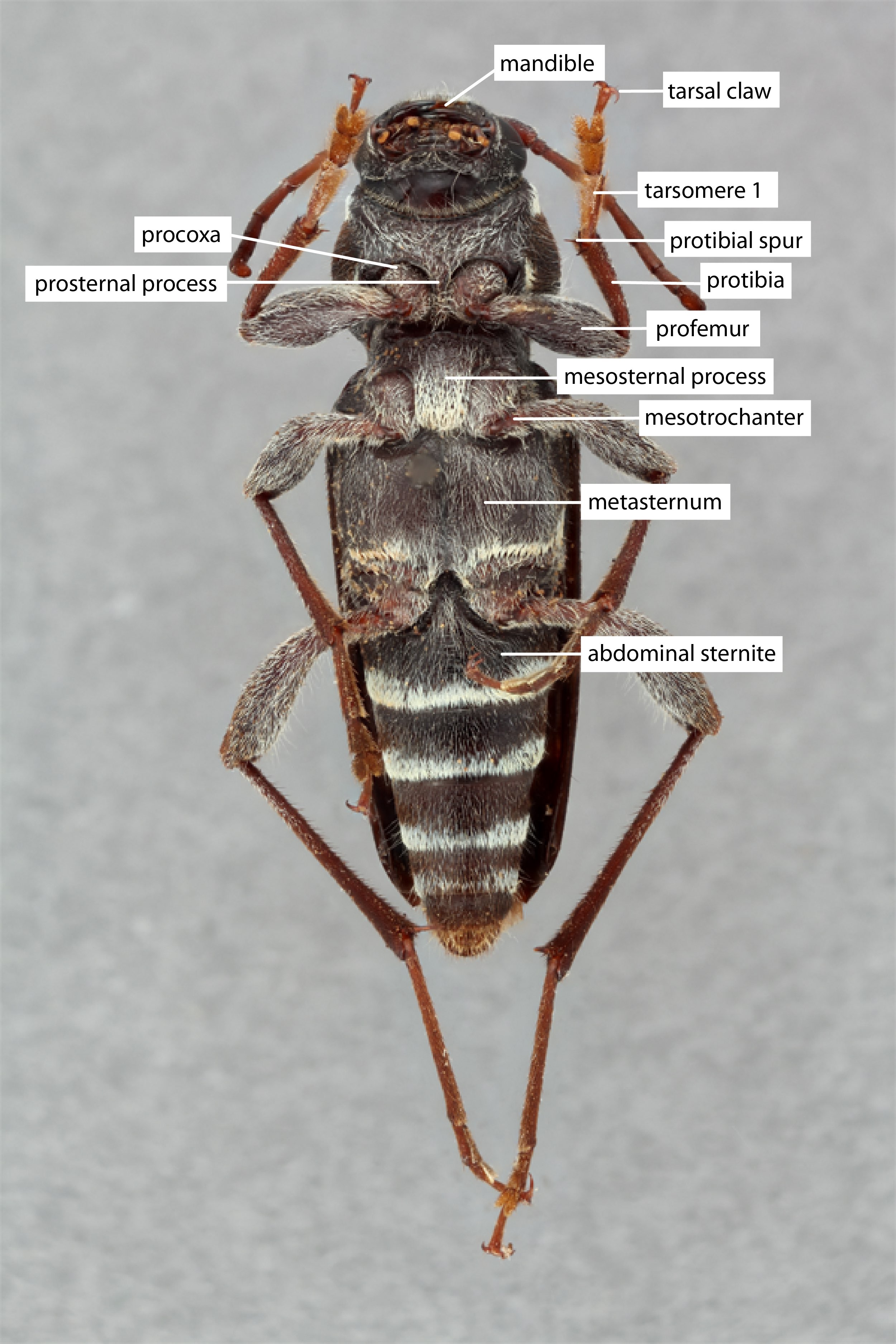 : 2, tarsal clawstarsal claw:
: 2, tarsal clawstarsal claw:
usually paired claws of the pretarsus, at the distal end of the leg simple.
simple.
Fronsfrons:
the upper anterior portion of the head capsule, usually a distinct sclerite between the epicranium and clypeus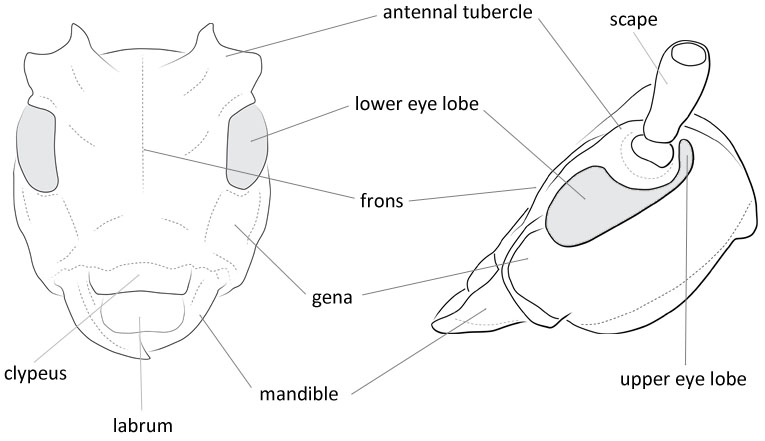 comparatively broad, flat, without carinaecarina:
comparatively broad, flat, without carinaecarina:
an elevated ridge or keel, not necessarily high or acute
, with longitudinal smooth line or groove in middle part of posterior half, and produced tubercletubercle:
a small knoblike or rounded protuberance
near antennal basebase:
the part of any appendage or structure that is nearest the body
. Antennaeantenna:
in larval and adult insects, paired segmented appendages, borne one on each side of the head, functioning as sense organs and bearing a large number of sensilla
shorter than body, thicken slightly toward apexapex:
end of any structure distad to the base
[C. japonicus (Chevr.)], rarely longer than body, thin [C. gracilipes (Fald.), male], contiguouscontiguous:
so near together as to touch
at basebase:
the part of any appendage or structure that is nearest the body
; space between antennaeantenna:
in larval and adult insects, paired segmented appendages, borne one on each side of the head, functioning as sense organs and bearing a large number of sensilla
less than distance between upper lobes of eyes. Pronotumpronotum:
the upper and dorsal part of the prothorax
laterally rounded, barely oblongoblong:
longer than broad
or even transversetransverse:
broader than long
, disk uniformly convex, with dense punctationpunctation:
pits or depression of variable size in cuticle
, and dense adherent and setaceous erect hairs. Elytraelytron:
the leathery forewing of beetles, serving as a covering for the hind wings, commonly meeting opposite elytron in a straight line down the middle of the dorsum in repose
truncate at apexapex:
end of any structure distad to the base
or with truncatetruncate:
cut off squarely at the tip
sharp outer angle; as an exception rarely rounded (C. motschulskyi); with dark brown and lightcolored adherent hairy coat forming characteristic pattern for each species, consisting of spots and transversetransverse:
broader than long
bands (Cherepanov 1988cCherepanov 1988c:
Cherepanov AI. 1988c. Cerambycidae of Northern Asia, Vol. 2. Cerambycinae, Part II. Oxonian Press, New Delhi 3: i–xi + 1–354, 153 figs.).
Rhaphuma, Demonax, Grammographus
The spinespine:
a protuberance with an acute (sharp) distal end
-free antennaeantenna:
in larval and adult insects, paired segmented appendages, borne one on each side of the head, functioning as sense organs and bearing a large number of sensilla
, slender femora, and first metatarsomere shorter than remaining 3 combined will distinguish among most close relatives.
Palearctic, Afrotropical, Indomalaya, Australasia, C. annularis introduced in SE Brazil and USA
many broadleaf; Pinus longifolia (cones)
272 spp. + 7 more subspecies. Conifers: C. strobilicola.
Clytus (Anthoboscus), Mulsant, 1862
Clytanthus Lacordaire, 1869
Caloclytus Gahan, 1906
Chlorophorus (Crassofasciatus), Özdikmen, 2011
Chlorophorus (Perderomaculatus), Özdikmen, 2011
Chlorophorus (Humeromaculatus), Özdikmen, 2011
Chlorophorus (Immaculatus), Özdikmen, 2011
Chlorophorus Chevrolat, 1863